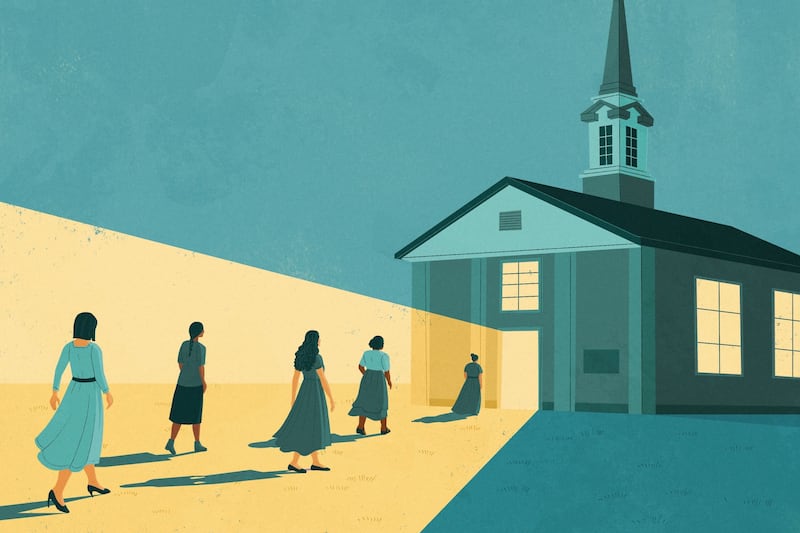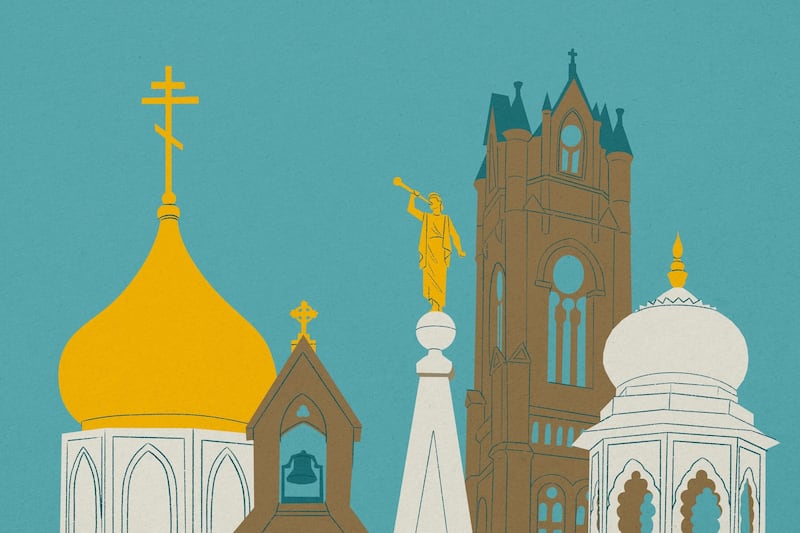This article was first published in the State of Faith newsletter. Sign up to receive the newsletter in your inbox each Monday night.
Last winter, I visited Grace City Church, a non-denominational congregation in the Boston area brimming with young adults in their 20s and 30s. I sat in the very back, alongside others perched on the floor with Bibles and coffee mugs in hand. As I spoke with attendees about their faith, I was struck by their passion for faith and community, and by the creative ways some expressed it through their religious practice.
One 26-year-old woman, Bri, told me she attends Grace City each week with her husband and baby. She loved the vibrant, welcoming community, and it was also familiar; she had grown up attending an evangelical church in the midwest.
But alongside the less formal non-denominational service, she also said that on occasion she observed Shabbat and Jewish holidays. For her, combining the more relational worship of Grace City with the grounding rituals of Judaism provided a spiritual balance. “There is a lot of value in the tradition and keeping things every week to bring yourself back to,” she told me.
Another young woman, a Harvard student who grew up Protestant in Alabama, told me she now splits her worship time between a Catholic church and a nearby non-denominational congregation. For her, Catholicism offers intellectual depth while the non-denominational services provide emotional resonance and an environment to socialize with her peers. (You can read more about this in my Deseret Magazine story about young people giving religion a chance.)
This kind of cross-pollination is increasingly common. A recent report by the Hartford Institute for Religion Research found that 46% of American churchgoers attend more than one congregation regularly. This shift is partly linked to the rise of online worship services after the COVID-19 pandemic, which made it easier and more convenient for people to explore or attend multiple churches.
The study, which surveyed over 24,000 churchgoers from 80 denominations, found that 22% physically attend multiple churches, 10% engage with others via livestream or broadcast and 14% do both. Still, the majority, 54%, report attending only one congregation.
Blending elements or practices from other traditions beyond your church “home” can offer a richer, more textured spiritual life.
For example, in addition to attending weekly services at The Church of Jesus Christ of Latter-day Saints, I often attend a Catholic mass at a parish where my son sings in a Catholic boy’s choir. The polyphony of the choral music and the steady rhythms of the liturgy have deepened my religious experience in ways that complement rather than compete with my primary faith tradition.
There are certainly challenges in engaging in multiple churches — navigating logistics and donations to two churches can be complicated. The same report found that those who attend more than one church tend to be less involved overall. “Those with multiple home churches are significantly less committed to the church they are attending, in terms of participation, giving, volunteering, and involvement in activities than those with a single church affiliation,” the report said.
Religious life in America is changing: the rise of the “nones” has stalled and young people are hungry for connection and meaning. With the ease of digital access and growing openness to personalized faith, some seekers are curating their own paths, blending traditional and modern worship, community and personal contemplation to create faith practices that speak to them.

Fresh off the Press
Chip and Joanna Gaines of Magnolia Network have been in the middle of a culture war clash after their new show “Back to the Frontier” featured a gay couple, along with their two sons. The response has sparked debate among the evangelical community, raising questions about representation, values and faith in media. A few thoughtful pieces explore what this moment tells us about reality TV and what it means to be a modern Christian in the public eye.
How the recent IRS filing is challenging the boundaries between faith and politics. “Our faith should inform our vote. Our votes shouldn’t drive our faith,” Amanda Tyler, executive director of the Baptist Joint Committee for Religious Liberty, told me.
Term of the Week: EB-4 visa
The EB-4 is a special U.S. employment-based green card category that allows “special immigrants,” which includes religious workers like pastors, nuns, imams and cantors, to apply for permanent residency. Initially, they would apply and serve under temporary five-year R-1 religious visas, according to AP.
For years, this pathway enabled thousands of foreign-born clergy to continue serving American congregations long-term. But in 2023, a sudden procedural change by the Biden administration lumped abused migrant minors into the same green card line, creating severe backlogs that jeopardize the legal status of religious workers, according to AP.
Many now face the expiration of their R-1 visas, AP reported, before their green cards can be processed, threatening faith communities, especially in underserved areas. A bipartisan bill in Congress aims to offer a “narrow fix” by extending visas while green card applications are pending and making sure religious workers can continue serving their congregations.
What I’m Reading
I learned a few new things from this New York Times’ story about the “Music & the Spoken Word” radio program. For example, I learned that to qualify to sing in the Tabernacle Choir, candidates go through a nine-month audition process, along with a written test. “Even as the world has changed, the purpose of the broadcast remains the same,” Derrick Porter, the show’s host, said while introducing the program at the 5,000th episode celebration, according to the article. “Thirty minutes of peace, broadcast freely to the world.”
Kelsey Dallas, a Deseret alum who is now managing editor at the SCOTUS Blog, breaks down the controversy around the display of the Ten Commandments in public school classrooms and explores how the current Supreme Court might approach the issue if it reaches the justices’ docket.
A new book, titled “Sacred Wonderland: The History of Religion in Yellowstone,” explores the religious history of the first national park. In a piece in The Conversation, Thomas Bremer, the author, explores how “Yellowstone has been a ‘sacred wonderland’ of spiritual power and religious activity for centuries – and for different faith groups.”
Odds and Ends
I’m continuing to explore what modern religious life looks like in practice — and I’d love your help. Do you blend practices from different faith traditions in your own life? Have you found meaning in attending more than one church, synagogue, mosque, or spiritual community or do you know someone who has?
Whether you’ve created a unique spiritual practice blending traditions or are just exploring beyond your “home” congregation – I’d love to hear your story. Email me at mmanzhos@deseretnews.com


